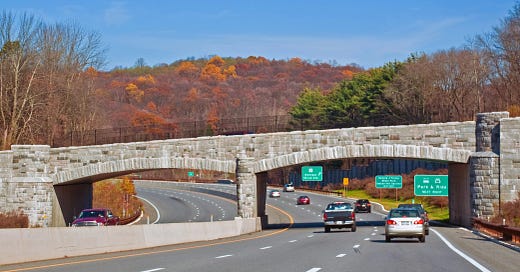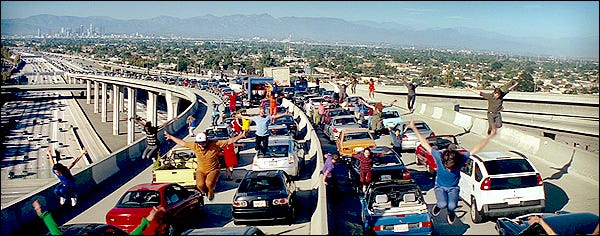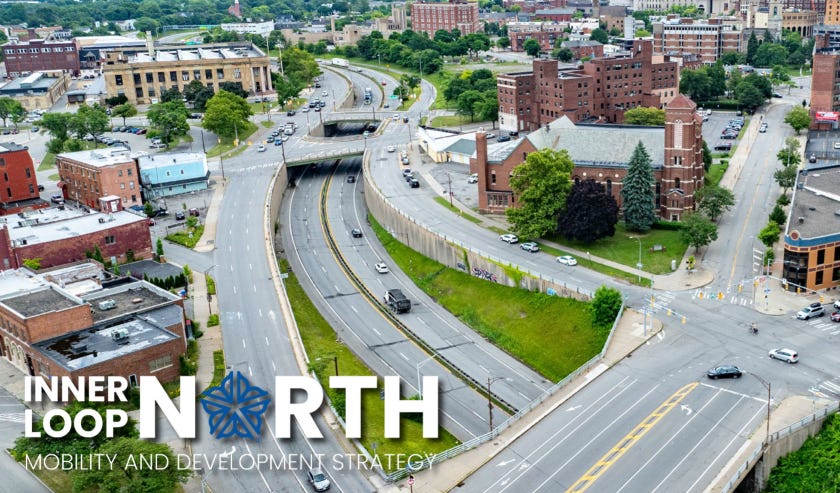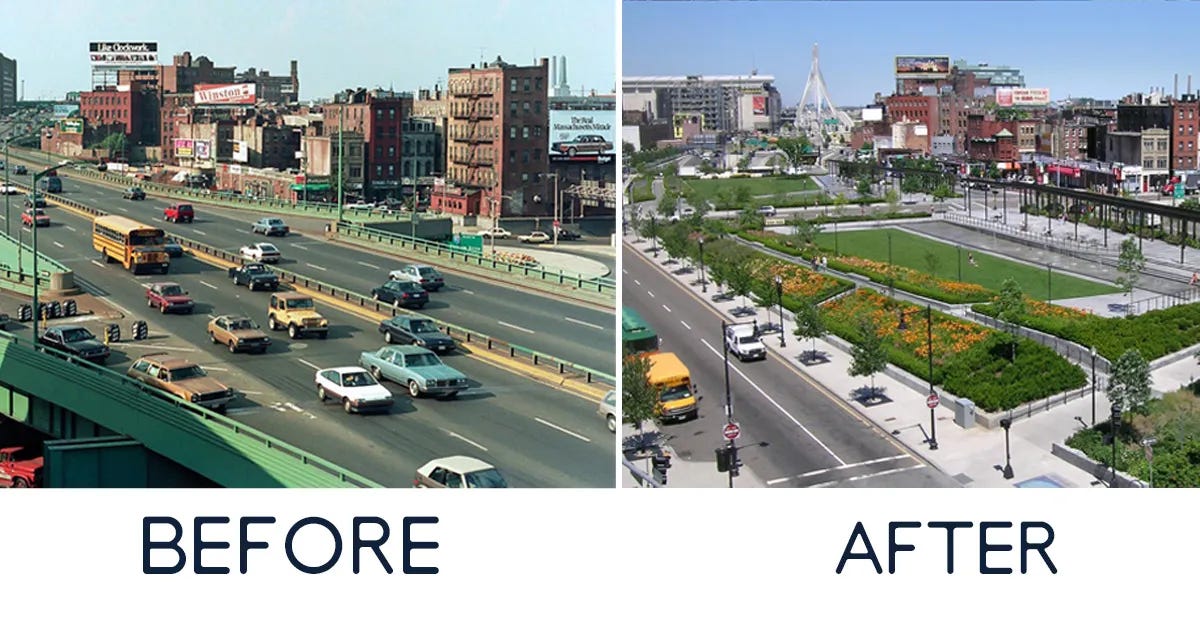The Effects of USA Freeways American Cities and Neighborhoods
The Good, the Bad, and the Racist
I have an ingrained love of freeways. I was born near the intersection of the Harbor and the San Diego Freeways (CA 11 (now I-110) and I-10). One of my earliest recollections is the drive down Artesia Blvd to the Long Beach Freeway to the Santa Ana Freeway to Disneyland. Getting to the freeways meant getting close to the fun! This explains why I approach this topic from the standpoint that freeways are wonderful.
But if I look at it now, as an adult, freeways are not always the wonder I remember. In many ways, they transport people quickly at the expense of downtown, historic, or minority neighborhoods.
The construction of freeways has changed the urban landscape, often exacerbating the segregation of cities and neighborhoods. Freeways serve as vital arteries for transportation and commerce (except at rush hour); their presence has also resulted in significant social, economic, and environmental consequences. This post delves into the social impact and beneficiaries of freeway construction in American cities.
Historical Context
The idea that “freeways” can be used to reinforce segregation predates the modern freeway trend. Arteries to New York City from north of the city and Connecticut were created as “parkways,” and many are still in use. If you drive one of these (like the Bronx River Parkway), they do not allow large trucks of buses. Using “parkways” prohibitions meant that buses, the traditional transportation of low-income workers, could not be used north of the city. This raised a near-impossible barrier for low-income workers from New York to move to the higher income, and whiter, suburbs.
Construction Craze Officially Starts
In 1956, President Eisenhower signed the Federal-Aid Highway Act to create the Interstate Highway System. This project aimed to develop a network of highways that would facilitate efficient transportation across the nation. While the intention was to boost economic growth and improve national defense, the implementation of these freeways often came at the expense of urban communities.
Effect on Communities
One of the most significant effects of freeway construction has been the physical division of cities and neighborhoods. Highways often cut through the heart of urban areas, creating barriers that disrupt the continuity of communities. This division has several repercussions. Since freeway construction started in the Jim Crow era, many of the negative impacts were ignored or even planned.
Freeways can act as physical and psychological barriers, separating neighborhoods and isolating residents. Their construction often affects low-income and minority communities the most, as they are likelier to be located near highway routes in inner cities. The construction of freeways often leads to the displacement of residents, the destruction of homes, and the loss of community cohesion. Often, the effects are or were actively encouraged by cities or the federal government to isolate or relocate minority communities. We will look at the case of the Rochester, New York’s Inner Loop Freeway as an example.
Rochester, New York, Inner Loop
Before constructing the Inner Loop, Rochester's downtown area was home to a thriving Black community known for its cultural vibrancy and economic activity. This neighborhood, defined by its close-knit social networks and local businesses, served as a hub of the city's African American life and identity.
The decision to route the Inner Loop Freeway through this neighborhood had catastrophic consequences. Entire blocks were razed, displacing thousands of residents and dismantling social and economic infrastructure. Homes, businesses, churches, and social clubs were demolished. The stated desire for improved automotive access led to the destruction of Black neighborhoods and drove the residents away from downtown.
Social Disintegration
The immediate effect of the highway construction was the forced relocation of Black families to other areas of the city, often to neighborhoods that were already economically disadvantaged and socially marginalized. This disrupted established social networks and resulted in a loss of essential communal support. For many residents, the destruction of their homes and neighborhoods was not just a physical loss but an erasure of cultural identity and historical legacy.
Economic Consequences
The economic ramifications of the construction were significant. The destruction of Black-owned businesses destroyed the livelihood and economic empowerment within the community. Displaced people faced challenges in reestablishing their businesses in new locations, often encountering financial barriers and systemic discrimination.
The long-term economic impact extended beyond the immediate loss of businesses. The displacement contributed to a cycle of poverty and limited economic mobility for future generations. The neighborhoods to which Black residents were relocated lacked the same access to resources, infrastructure, and opportunities, perpetuating socio-economic disparities.
Racial Impact in Rochester
The construction of the Inner Loop reinforced and exacerbated patterns of racial segregation in Rochester. By physically dividing communities and creating barriers to mobility, the highway served as a literal divide between white and Black neighborhoods. This segregation was further compounded by discriminatory housing policies and practices that restricted where Black families could reside.
The result was a cityscape characterized by sharp racial and economic divisions. The effects of this segregation remain evident today, manifesting in disparities in education, employment, housing, and health outcomes between Black and white residents.
In recent years, efforts have been made to address the legacy of the Inner Loop. One such initiative is the partial filling of the Inner Loop East, which aims to reconnect neighborhoods and revitalize urban development.
Other Cities
Sadly, Rochester's experience was not an isolated incident. Similar situations occurred in many locations: St. Paul (I-94), Miami (I-95), Detroit (I-81), Atlanta (I-20), and many more examples.
In my hometown of Los Angeles, the Santa Monica Freeway (I-10) stretches from Downtown Los Angeles to the Pacific Ocean in Santa Monica. North of the freeway are the traditional “white” areas of the city: Hancock Park, West Los Angeles, Miracle Mile, etc. South of the freeway were the traditional Black neighborhoods: Pico, Sugar Hill, and West Adams. Since the construction in the 1950s, the neighborhoods south of the I-10 have been more isolated from economic opportunities and become poorer and more segregated. Gentrification is occurring now, which benefits the local economy and new residents but poses challenges for current minority residents.
Economic Disparities
The presence of freeways can lead to economic disparities within cities. Neighborhoods adjacent to highways often experience decreased property values and reduced investment. Businesses may suffer due to decreased foot traffic and increased noise and pollution. Conversely, suburban areas with convenient freeway access may increase development and economic growth, exacerbating existing inequalities.
Transportation Inequity
The focus and money spent on freeway construction often comes at the expense of the local public transportation systems. This can lead to transportation inequity, where residents without access to cars are left with limited mobility options. This disproportionately affects low-income communities, who rely more heavily on public transportation.
In Los Angeles, the growth of freeways led to the dismantling of the “Red Car” transportation system that was widespread and convenient. The bus routes since then have never been an adequate replacement.
Who Benefits from Freeways
While the negative impacts of freeway construction are significant, certain groups do benefit from these developments:
Suburban Residents
Freeways facilitate suburbanization, allowing residents to live further from urban centers while maintaining access to city amenities. This leads to increased suburban development and economic growth in these areas. Suburban residents benefit from reduced commute times and increased access to job opportunities. These advantages dissipate in time, as suburbs grow and overwhelm freeways with traffic.
Big Businesses and Commerce
Businesses that rely on transportation, such as logistics and retail companies, benefit from the efficient movement of goods facilitated by freeways. The increased connectivity can lead to expanded markets and reduced transportation costs, boosting economic growth.
Automobile Industry
The construction of freeways has historically benefited the automobile industry, encouraging car ownership and driving demand for vehicles. This has made significant profits for car manufacturers and related industries such as oil and gas.
New Freeways come with massive costs
As cities and populations have grown, the cost of building freeways has also dramatically increased. Freeways are built where they are needed, and they are deemed necessary in heavily urban environments, so eminent domain purchases have to occur. New Freeways are subject to a much more stringent (and expensive) development environment.
The costs of freeways are very rarely levied on users. They are traditionally paid for by the government from general taxes, which means everyone pays for them. Even if low-income or carless cannot use them, they pay for them as a public good. There are gas-taxes, which were dedicated to highway construction and maintenance. But gas-taxes are almost never raised. Car owners are one of of the most listened to constituents by politicians.
Some newer toll-roads do charge for access. In places - like the Orange County, California - private operators can help to underwrite costs and therefore charge for access. In some of the most egregious examples, like C73 and CA 241, toll roads charges can be purchased that are purposefully built to avoid traffic jams. It is a different type of segregation built on wealth, not race.
Changing Priorities
Some cities have removed or buried freeways for the betterment of their citizens. It is not always popular and never inexpensive. Two examples are shown below:
The Embarcadero Freeway
A freeway was built along the shoreline in San Francisco in 1968. The promise of faster access to the dockyards north of the city led to the construction of a two-story freeway—westward traffic on one level, eastward traffic on the other. It was unattractive and unloved as tourism took hold in the area, particularly Pier 39. But freeways, once built, are almost impossible to remove. The Embarcadero Freeway was removed only after an earthquake destroyed it. The area has been rehabilitated now that the freeway is gone.
The ”Big Dig” in Boston
"The Big Dig," officially the Central Artery/Tunnel Project (CA/T), was a massive highway infrastructure project in Boston that rerouted the elevated Central Artery (I-93) into an underground tunnel, extended the I- 90 to Logan International Airport, and created the Rose Kennedy Greenway. The cost and travel disruptions were challenged in court, drawing the construction out even longer. Despite the positive effect on downtown, there were, and still are, arguments that the money would be better spent somewhere else.
Conclusion
Freeway construction has become more expensive and lengthy. It is not just construction or eminent domain but a bureaucratic nightmare of lawsuits, environmental reports, NIMBYism, and shifting priorities.
There are initiatives to remove this impediments, but I am not sure they are great either. Freeways are tied to a system of transportation that barely works, when there might be better answers. An earlier experiment was the introduction of “car-pool” lanes that promises quicker travel times for cars with multiple passengers. It’s benefits and questionable.
Better public transportation and use of dedicated lanes for public transportation is beginning to move people out of single driver trips. The problem here is that once freeway traffic is lighter, people who can move back to single driver experiences.
Taking lanes away for public transportation is so controversial that great cost is often spent to expand a freeway and add new lanes for this.
The limiting factor on changing freeways is the way our entire economy has become dependent on the movement of goods quickly to local markets nationwide. Trucking, which needs highways to produce results, will continue to be built and expanded. Perhaps the best we can do is learn from our previous experience in design and alternate opportunities.







